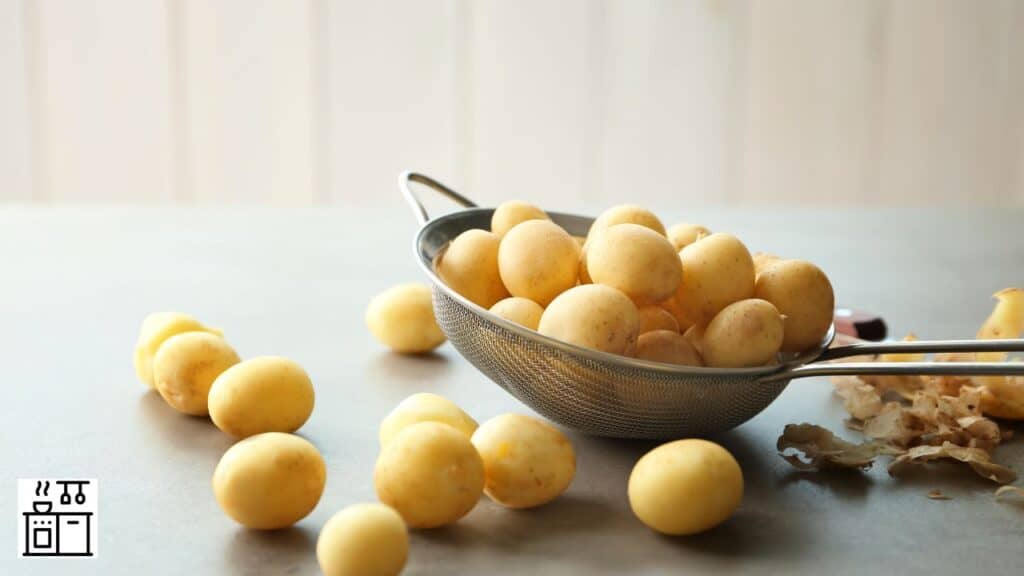There are many instances during food prep and cooking when you must separate ingredients.
A strainer is useful for such purposes, like draining water from pasta, washing fruits and vegetables, or sifting dry ingredients.
In general, food strainers help to remove impurities, achieve the desired texture of food, and facilitate baking processes.
Let’s take a closer look at the different types of strainers available and the purposes they meet.
Different Uses of Strainers
Food strainers are essential in kitchens because you can use them for any of the following purposes.
1. Straining Liquids
When cooking ingredients like rice, pasta, and food grains in water or liquids, you will most likely have to remove the excess liquid after cooking.
You can use a strainer to easily drain the water from the cooked ingredient while keeping the solid content in the pot.
2. Washing and Rinsing Fruits, Vegetables, and Food Grains
Another common use of strainers is to clean fruits, vegetables, and food grains.
In this case, you can place the fruits or vegetables to be washed inside the strainer and run it under water.
The water will wash away dust and impurities and take them away.
3. Separating Solids from Liquids
When making curd or homemade cheese, you must separate the solid component from the liquid in the mixture. A strainer facilitates this.
Pouring the entire mixture through the strainer makes the liquid flow out of the strainer, while the solid remains inside.
4. Separating Dry Ingredients
Ingredients like sugar, cocoa, or flour often have lumps.
You can separate the dry ingredients from the lumps, while also breaking up the lumps by passing the dry ingredients through a food strainer.
This proves very useful in baking, where even smooth-flowing ingredients improve the texture of the baked items.
Different Types of Strainers
A variety of strainers are used in kitchens based on the task and type of ingredients you work with.
Here are the most common types of food strainers.
- Mesh strainers: A mesh strainer is also called a sieve. This strainer has a fine mesh or perforated surface that retains solids while allowing liquids to flow through. You can use it to separate solids from liquids and for sifting dry ingredients. You can also use it to separate liquid from sauces and soups.
- Colanders: Colanders look like large bowls. They hold a large volume of ingredients. However, the notable factor is colanders have holes or perforations in the base. Colanders are very useful for draining pasta, rice, and other large ingredients. The holes can be tiny or large. Either way, they will hold solid ingredients like rice and pasta in place. Meanwhile, liquids like cooking water or broth can easily pass through the hole.
- Tea strainers: Tea strainers are small kitchen tools. They have a fine mesh with tiny perforations. As the name suggests, these strainers are useful to separate the tea leaves from liquid tea. You can also use them to strain herbs or spices mixed with water or liquid. Tea strainers will usually have a handle or a hook that you can place over the rim of a pan or cup.
- Chinois Strainers: Chinois strainers are not too common in household kitchens. But you will see them in professional kitchens. They are widely used to strain sauces, stocks, and purees. By passing mixtures through these strainers, you will obtain a smooth puree without any clumps or bits. It removes even tiny particles.
- Spider strainers: Spider strainers are also called skimmers. They have a wide but shallow bowl and a long handle. These strainers are usually made of mesh or perforated material. You can use them to scoop out deep-fried ingredients from hot oil or water after frying, steaming, or poaching.
- Fabric strainers: Fabric strainers are made of mesh or cloth. They are commonly used to separate liquids from semi-solid or solid ingredients. The fine perforations in the fabric allow the liquid to pass through while retaining the thicker semi-solid or solid ingredients. One popular use of fabric strainers is to separate whey from yogurt or curds. You can also use it to make nut milk, like almond milk or other plant-based milk.
Steps to Use Strainers

Using a food strainer is a simple process. Here are the steps to make use of them.
1. Choose the Right Strainer for The Purpose
As we mentioned earlier, there are different strainers. Each of them is better suited than the others for a specific purpose.
So, depending on the food you wish to separate, choose the best strainer.
2. Prepare the Ingredients for Straining
If you are straining solids from a liquid, ensure that your liquid is ready.
For straining solid mixes, make sure that the ingredients are cooked or prepared accordingly.
3. Place the Strainer Over a Suitable Container
Depending on the quantity of food you collect in the strainer, you will need a suitable container for straining.
A large bowl or pot will be needed for straining large amounts of liquids like water from pasta or rice.
Meanwhile, you can work with a smaller vessel for straining juice or nut milk.
If you don’t need to retain the liquid that is strained, you can also place the strainer over a sink.
4. Pour the Food Into the Strainer
Once you set a strainer in position, you can pour the contents into the strainer to begin the process.
Be careful while pouring liquids into the strainer to prevent them from spilling over the sides.
Similarly, if you are separating solids, gently transfer the solid into the strainer to keep it balanced.
5. Wait for The Liquid to Drain
The bulk of the liquid will immediately pass through the sieve and collect in the vessel beneath it. However, some liquid will remain.
Wait for some time to allow all the liquid to separate from the contents in the strainer.
If needed, you can gently press the contents of the strainer to extract maximum liquid as possible.
If you are straining a solid mix, you can break up any clumps using a spatula to aid the straining process.
6. Shake or Tap the Strainer
Shaking or tapping the strainer will further help the straining process.
It will also help to remove any excess liquid and encourage food to pass through.
7. Discard the Strained Material
Depending on what you are straining, your required material may remain in the strainer or fall into the vessel below it.
For instance, if you are straining pulp from the juice, you will be more interested in the collected liquid than the contents of the strainer.
Meanwhile, while straining cheese, you will want the content of the strainer while discarding the liquid.
In either case, get rid of the ingredient that you don’t need and transfer the rest to a storage container.
8. Clean the Strainer Thoroughly
Since strainers have tiny holes, you must clean them quickly.
Putting them aside without cleaning will cause the solids to stick to the surface, making them difficult to dislodge later.
Wash the strainer with warm soapy water after use to remove all the residue.
Steel or metal colanders can usually go in the dishwasher, but check the instructions to confirm.

